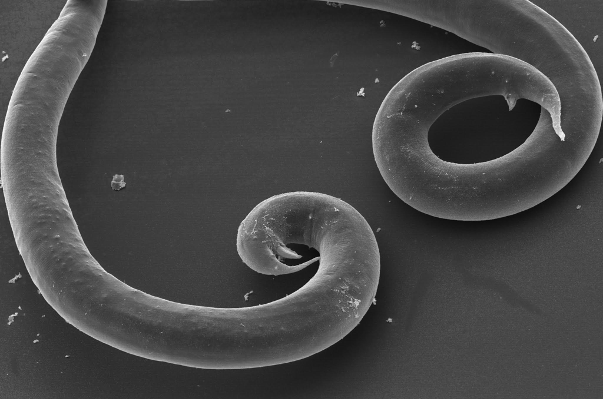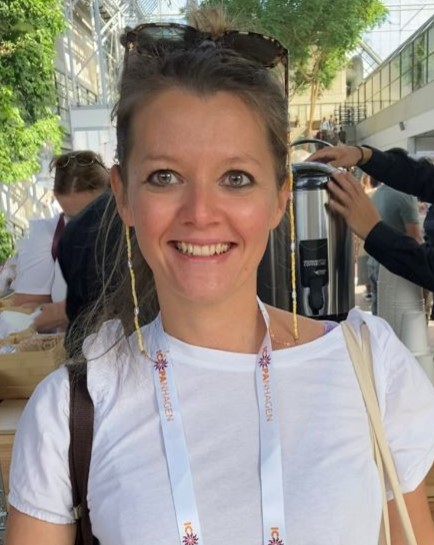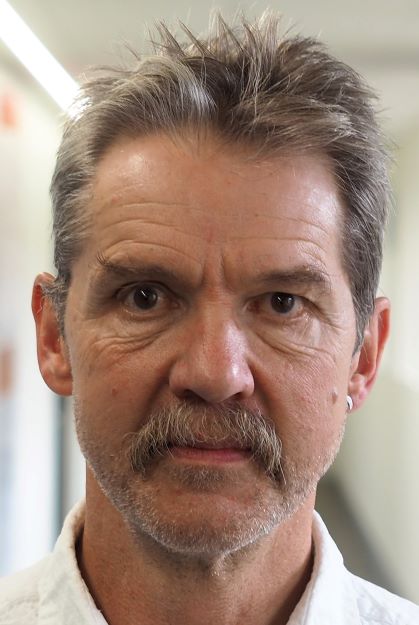Links to external sources may no longer work as intended. The content may not represent the latest thinking in this area or the Society’s current position on the topic.
Strongyloides: omics to worm-free populations

Theo Murphy meeting organised by Dr Vicky Hunt, Dr Adrian Streit, Dr Dora Buonfrate, Professor James Lok and Professor Peter Odermatt.
This meeting brought together basic and applied scientists working on the neglected tropical disease strongyloidiasis, caused by the soil-transmitted helminth Strongyloides. The aims of this meeting were to:
- Share and present the latest research
- Discuss future priorities and goals in the field including treatment and control strategies
- Identify areas of overlap between disciplines and forge collaborations and networks
An accompanying journal issue has been published in Philosophical Transactions of the Royal Society B.
Attending this event
This meeting has taken place.
Enquiries: contact the Scientific Programmes team
Image credit: Adrian Streit
Organisers
Schedule
| 09:05 - 09:35 |
The epidemiology and control of soil transmitted helminths – the special case of Strongyloides stercoralis
The paper will discuss our current understanding of the epidemiology and control of the soil transmitted helminths (STH) with special reference to Stronglyloides stercoralis. Progress in reducing the prevalence’s of STH globally over the past two decades will be highlighted. This has been achieved by employing the two key control methods which are repeated rounds of mass drug administration, largely targeted to school age children, and clean water provision, plus improvements in hygiene and sanitation (WaSH). The focus will be on the transmission dynamics of the parasite under the impact of repeated rounds of mass drug administration and what levels of coverage and individual compliance to treatment would be required to eliminate transmission in defined transmission settings (low, medium and high values of the basic reproductive number R0), employing individual based stochastic models of the known epidemiology of S stercoralis. Emphasis will be placed on what groups to treat, and how often to treat, to reduce prevalence to very low levels. Gaps in our knowledge of key biological processes and important epidemiological parameters will be highlighted, as will the challenges faced in both elimination S stercoralis as a public health problem, and eventually stopping transmission in areas of endemic infection. 
Professor Sir Roy Anderson FMedSci FRS, Professor of Infectious Disease Epidemiology, Imperial College London

Professor Sir Roy Anderson FMedSci FRS, Professor of Infectious Disease Epidemiology, Imperial College LondonSir Roy is currently Professor of Infectious Disease Epidemiology in the School of Public Health, Faculty of Medicine, Imperial College London and Director of the London Centre for Neglected Tropical Disease Research. His past posts include, the Chief Scientist at The UK Ministry of Defence, and Rector of Imperial College London. He is the author of over 650 scientific articles and has an h index of 133 in google scholar. Among many past commitments, he served as a Trustee of the Natural History Museum London, and as a non-executive director of GlaxoSmithKline for ten years. He is currently Chair of Oriole Global Health Ltd, a Vice President of Fauna and Flora International, Trustee of the London Institute of Mathematical Sciences and of the Banga charity. Sir Roy was elected Fellow of the Royal Society in 1986, a Founding Fellow of the Academy of Medical Sciences in 1998, and a Foreign Associate Member of both the National Academy of Medicine at the US National Academy of Sciences in 1999 and of the French Academy of Sciences in 2010. He was knighted in the 2006 Queen's Birthday Honours. |
|---|---|
| 09:25 - 09:35 | Discussion |
| 09:35 - 10:05 |
Open questions in Strongyloides stercoralis biology - bringing the diversity to the lab
S stercoralis shows considerable within-species DNA sequence diversity and various populations show differences in their life cycle preferences. Dogs can carry S stercoralis indistinguishable from the ones in humans, in addition to apparently dog-specific types. These findings lead to the questions: is S stercoralis one species or rather a species complex and if the various types differ in their pathogenicity and if the different life cycle preferences are genetically or environmentally specified? To address these questions, in addition to directly analysing worms collected from the field, controlled laboratory experiments are desirable. The latter requires that the isolates of interest are maintained in laboratory culture. The group aims at establishing a collection of S stercoralis isolates by culturing them in gerbils and cryo-preserving them alive. For each isolate, a set of parameters (eg life cycle preference, sex ratio, genome sequence) will be determined and the species status of the isolates will be evaluated by interbreeding experiments. Isolates that differ in interesting ways will be used for QTL and GWAS studies. The group hopes to encourage people encountering S stercoralis to contribute their isolates to our collection. All strains and information will be made available to the community. 
Dr Adrian Streit, Max Plank Institute, Germany

Dr Adrian Streit, Max Plank Institute, GermanyAdrian Streit studied Biology at the University of Berne, Switzerland and obtained a PhD from the same institution in 1994 (with D. Schümperli). After postdoctoral stays at the Universities of Colorado at Boulder, USA (with W.B. Wood), Zurich, Switzerland (with M. Zwicky) and Fribourg, Switzerland (with F. Müller), in 2003 he established his own research group in the Department of Integrative Evolutionary Biology (director R.J. Sommer) at the Max Planck Institute for Developmental Biology (since 2022 MPI for Biology Tübingen) at Tübingen Germany. The focus of his research transitioned gradually from the model nematode C. elegans to parasitic nematodes, predominantly intestinal parasites of the genus Strongyloides. Currently his group focuses on investigating life history switches in Strongyloides spp. and engages in field parasitological projects aimed at studying the population biology and the zoonotic potential of S. stercoralis. |
| 09:55 - 10:05 | Discussion |
| 10:05 - 10:35 |
Environmental health hardware, environmental sources of Strongyloides stercoralis and strongyloidiasis transmission.
In Australia, strongyloidiasis primarily affects returned travellers, Vietnam veterans and refugees or asylum seekers. Non-overseas acquired cases are seen almost exclusively in Australian Indigenous remote communities. We know that person to person transmission is low or non-existent, based on a study of wives of Vietnam veterans in Australia who did not contract the disease. The environmental reservoirs of Strongyloides stercoralis must play an important role in locally acquired strongyloidiasis. Therefore, in order to address transmission, we need to better understand the environmental components of the S. stercoralis lifecycle. This is also important as some Strongyloides species have demonstrated resistance to ivermectin, meaning that our best clinical intervention might be at risk. This talk will summarise the group’s work reviewing the global research on the environmental sources of Strongyloides. sp. and discuss their current approaches to determining the environmental reservoirs of S. stercoralis, looking at dogs, flies and wastewater. Additionally, their work has shown that strongyloidiasis is a disease of poverty. Acknowledging this is important, we need to shift the lens to socioeconomic factors, particularly environmental health hardware such as working showers and laundries, and effective wastewater and rubbish removal. 
Dr Kirstin Ross, Flinders University, Australia

Dr Kirstin Ross, Flinders University, AustraliaKirstin Ross coordinates the courses in Environmental Health at Flinders University, South Australia, and has a strong interest in community engagement on environmental health issues. She is a member of Strongyloides Australia Inc., the group that advocates for strongyloidiasis research and policy change in Australia. She is interested in the environmental reservoirs of Strongyloides stercoralis, and is currently looking at dogs, flies and wastewater as potential transmission reservoirs. She is also interested in the role that environmental health hardware and economic disadvantage plays in strongyloidiasis transmission. |
| 10:25 - 10:35 | Discussion |
| 10:35 - 11:05 |
Break
|
| 11:05 - 11:35 |
Is Strongyloides stercoralis a zoonosis from dogs?
Strongyloidiasis remains a major veterinary and public health challenge globally. This chronic and potentially life-long disease has fatal outcomes in immunosuppressed people and dogs. Currently, the role of companion animals in the transmission cycle of human strongyloidiasis remains enigmatic. While zoonotic transmission to humans from companion animals has been proposed, this has not been confirmed. Cross-infection experiments between dogs and people during the 20th century suggested that S. stercoralis represents a species complex, with differing capacities for cross-species transmission. Recent genotyping studies of Strongyloides from dogs, cats, non-human primates and people indicate that S. stercoralis is indeed a species complex, containing at least three taxa, and likely more. One taxon has been demonstrated to infect cats, dogs and humans (designated S. stercoralis), a second appears specific to dogs (provisionally named “S. canis”). Despite recent advances in Strongyloides genotyping, sufficiently discriminatory tools to prove transmission from one host to another have not yet been developed. It remains unclear if dogs act as a zoonotic reservoir for human infection, or vice versa, or if this occurs only in some regions of the world and not in others. These questions must be answered before effective control strategies for strongyloidiasis can be instituted. 
Dr Richard Bradbury, Federation University, Australia

Dr Richard Bradbury, Federation University, Australia
Biography will available soon
|
|---|---|
| 11:25 - 11:35 | Discussion |
| 11:35 - 12:05 |
Strongyloides infections at the human–nonhuman primate interface
Understanding the epidemiology of multiple-host pathogens is considered one of the greatest challenges in infectious disease research. The close phylogenetic relationship between humans and nonhuman primates (NHPs) results in a partial overlap of their pathogens. The possibility of disease transmission between these two groups has increased in recent years due to closer and more frequent contact through habitat expansion and activities such as habituation for ecotourism. Several studies have attempted to uncover the transmission patterns of Strongyloides infections between humans and NHPs in both Africa and Asia. While S. f. fuelleborni has been described in wild NHPs and humans sharing the same environment, S. stercoralis appears to be restricted to NHPs living primarily in captivity, suggesting transmission by other animals or humans. The Dzanga-Sangha Protected Areas in the Central African Republic are known for habituated western lowland gorillas and BaAka people, traditional hunter-gatherers, while mountain gorillas in Virunga have been well known since Dian Fossey. Although humans and wild NHPs are in daily contact in DSPA, S. stercoralis has only been detected in humans, and S. f. fuelleborni found in NHPs differed from those found in humans, whereas S. stercoralis has been detected in wild mountain gorillas. |
| 11:55 - 12:05 | Discussion |
| 12:05 - 12:35 |
Harnessing Strongyloides for the development of novel parasite diagnostics and therapeutics
A step-change in the management of parasitic nematodes is urgently required to address global parasite disease burdens and the growing productivity demands of a rapidly expanding population. The global parasite problem is exacerbated by overreliance on a limited range of anthelmintics and a lack of sensitive, and quantitative, point-of-care diagnostics. The discovery and validation of improved diagnostic tools and novel anthelmintic control targets relies on the exploitation of platforms that harness relevant and tractable nematode parasites for research. Strongyloides parasites possess a uniquely tractable lifecycle, high-quality ‘omics’ resources, and advanced functional genomics tools, that are ripe for exploitation in fundamental helminth research and the discovery of novel parasite diagnostic and control approaches. Strongyloides related research at Queen’s University Belfast is centred on harnessing these experimental attributes to: (i) investigate uncharacterised facets of nematode neurobiology, including the role and importance of endocannabinoid signalling; (ii) better understand the role of antimicrobial peptides in parasite nematode biology and their ability to influence host microbiomes and (iii) identify putative novel parasite and/or host-derived diagnostic biomarkers associated with parasite infection. This presentation will provide an overview of how the Strongyloides platform supports these research themes and drives the improved diagnosis and management of parasitic nematode pathogens. 
Dr Louise Atkinson, Queen's University Belfast, Northern Ireland

Dr Louise Atkinson, Queen's University Belfast, Northern IrelandDr Louise Atkinson is a Lecturer in Molecular Parasitology at Queen’s University Belfast. Louise graduated from QUB in 2005 (BSc Hons Biological Sciences) and obtained a PhD from QUB in 2009 on the neurobiology of the human blood fluke Schistosoma mansoni. Louise was then a Post-Doctoral Research Assistant (2010-18) studying the neurobiology of Ascaris suum and several other agriculturally relevant parasitic nematodes until she was appointed as a Lecturer at QUB in 2018. Louise’s post-doctoral experience shaped her current research interests which focus on exploiting parasitic nematode functional genomics platforms, including in Strongyloides species, to probe aspects of parasitic nematode neurobiology. In addition, alongside several collaborators, she is interested in employing tractable nematode parasites to study host-parasite and parasite-microbe interactions. She has >20 published articles in parasitic helminth biology and has delivered invited speaker presentations at international conferences. |
| 12:25 - 12:35 | Discussion |
| 12:35 - 13:35 | Lunch |
| 13:35 - 14:05 |
Strongyloides genomics and genetics – can we catch up with C. elegans?
As well as an important cause of disease in humans and livestock, Strongyloides spp. are well suited as a laboratory model for parasitism. The genome assemblies of four Strongyloides species were published in 2016 and the S. ratti genome is one of the most contiguously assembled genomes of any nematode. There is also a growing database of transcriptome, proteome and small RNA data (published and unpublished) for Strongyloides spp. However, there is still a lot we don’t know about Strongyloides genomics and genetics. Using C. elegans as a benchmark, we can start to identify where the gaps in our knowledge are. For example, most of the available transcriptome data for Strongyloides is based on single time points and is lacking information about UTRs (important for understanding gene regulation). Here, Dr Hunt will present a summary of what we know about Strongyloides genomic and genetics including some of her group’s ongoing projects investigating gene organisation and expression of protein-coding genes and small RNAs. She will also discuss areas where data is lacking, for example, there is an underrepresentation of data from natural populations. Further improving data availability and better understanding the genomic and genetic basis of parasitism will elevate Strongyloides as a model organism for studying parasitism and could also be informative for improving strategies for treating and controlling helminth infections. 
Dr Vicky Hunt, University of Bath, UK

Dr Vicky Hunt, University of Bath, UKBiography will available soon |
|---|---|
| 13:55 - 14:05 | Discussion |
| 14:05 - 14:35 |
Proteomics approaches for strongyloidiasis: parasite, host and human disease
The use of proteomics to study human strongyloidiasis and its aetiological agent Strongyloides stercoralis has been so far limited, even though the well-known potential of these approaches for elucidating the molecular mechanisms associated with parasitism and to highlight novel immunological and diagnostic markers. Here the group employed targeted and untargeted proteomics approaches to investigate human strongyloidiasis at different levels. Particularly, by targeting specific host-derived circulating immune factors they have shown that long-lasting strongyloidiasis is not associated with the classical shift towards a type 2 immune response, but rather with a decrease in circulating chemokines, suggesting that immune cell recruitment to the infection site might be dampened in these patients. The untargeted proteomics investigation of the same patients revealed further systemic proteins significantly modulated during the infection or following treatment. When applied to the characterisation of infective larvae (iL3), this latter approach provided the largest iL3 proteome and experimental evidence about the most represented proteins associated with S. stercoralis parasitism, as inferred from genomic and transcriptomic data. Additionally, a semi-automated proteome annotation highlighted 9 proteins with potential immunogenic properties. In conclusion, the investigation of parasite- and host-derived proteins can significantly expand our understanding of host-pathogen interaction and contribute to improve current serodiagnosis. 
Dr Natalia Tiberti, IRCCS Sacro Cuore Don Calabria Hospital, Italy

Dr Natalia Tiberti, IRCCS Sacro Cuore Don Calabria Hospital, ItalyDr Tiberti started her research career on neglected tropical diseases at the University of Geneva were she obtained her PhD in 2013 on the study of biomarkers for human African trypanosomiasis (HAT). She then pursued her research as a post-doctoral fellow at the University of Technology Sydney and at the University of Geneva to study extracellular vesicles in host-pathogen interaction in cerebral malaria and HAT. Dr Tiberti is now a research scientist at the Department of Infectious, Tropical Diseases and Microbiology (DITM) of the IRCCS Sacro Cuore Don Calabria Hospital (Negrar) where she works on biomarkers and host-pathogen interaction in neglected tropical diseases, with particular interest on strongyloidiasis. The ultimate goal of her research is to improve the diagnosis and the comprehension of the pathophysiology of NTDs. |
| 14:25 - 14:35 | Discussion |
| 14:35 - 14:50 |
piRNA-like small RNAs target transposable elements in a Clade IV parasitic nematode
Small RNAs (sRNA) are short non-coding RNAs important for the regulation of gene expression via post-transcriptional gene silencing. The majority of sRNA research within nematodes has been carried out in the Clade V free-living model organism Caenorhabditis elegans which possess all three classes of sRNAs. Recent studies have shown that sRNA pathways are highly diverged in nematodes and C. elegans does not closely represent the sRNAs used by more distantly related nematodes, including parasitic species. For example, the PIWI pathway and PIWI-interacting RNAs (piRNAs) are involved in regulating and silencing transposable elements (TE) in most animals but have been lost in nematodes outside of the C. elegans group (Clade V). Little is therefore known about how nematodes outside of this clade regulate TEs in the absence of the PIWI pathway. Here, the group investigated the role of sRNAs in the Clade IV parasitic nematode Strongyloides ratti by comparing two genetically identical adult stages (the parasitic female and free-living female). They identified putative small-interfering RNAs that are differentially expressed between the two adult stages. A parasite-associated class of 21-22 nucleotide long sRNAs with a uridine 5'-monophosphate (21-22Us) were predicted to regulate and target TE activity. The 21-22Us show striking resemblance to the 21U PIWI-interacting RNAs found in C. elegans, including an AT rich upstream sequence, overlapping loci and physical clustering in the genome. This is the first report of a piRNA-like sRNA class of 21-22Us that have been identified specifically in the PF of Strongyloides and in nematodes outside of Clade V. |
| 14:50 - 15:05 |
Strongyloidiasis in semi-captive baboons at Knowsley Safari
As part of their drive through safari experience, Knowsley Safari (KS) offers its visitors a close-up encounter with their colony of olive baboons (Papio anubis) from the safety of their vehicles. Exiting vehicles, however, are sometimes contaminated with baboon faeces, posing a small health hazard. Coinciding with an animal welfare check, a coprological survey of baboon stool, both obtained from sleeping areas and cars, was conducted. Faecal material was examined by standard parasitological methods inclusive of: QUIK-CHEK RDT (Giardia), Kato-Katz coproscopy (Trichuris) and charcoal culture (Strongyloides). Across a four-day period, a total of 2,662 vehicles were examined with just under 700 stools obtained. Some 11.4% of vehicles were contaminated with faecal material. Overall prevalence of giardiasis was 37.4%, trichuriasis was 48.0% and strongyloidiasis was 13.7%. Since no faecal cysts of Giardia could be seen by microscopy, alongside very low levels of DNA detected by faecal PCR, these RDTs results were judged misleading. Further DNA characterisation confirmed the presence of Trichuris trichiura and Strongyloides fuelleborni. The latter observation represents this species’ most northern report of natural transmission. To minimise any public health risk, a future blanket administration of anthelminthic(s) is recommended, with later coprological inspection(s) to ascertain reinfection levels. |
| 15:05 - 15:35 | Break |
| 15:35 - 16:05 |
Skin-penetration behaviors of Strongyloides species
Skin-penetrating infective larvae actively search for hosts to infect and then invade hosts by skin penetration. We are interested in understanding host-seeking and host-invasion behaviors. We are using Strongyloides stercoralis and Strongyloides ratti for these studies because of their unique amenability to molecular genetic manipulation. We previously showed that Strongyloides infective larvae are attracted to host-emitted odorants and host body temperature. In this talk, I will focus on our recent investigations into skin-penetration behavior. We found that infective larvae penetrate skin by pushing their head into the skin while waving their mid-body and tail in the air. Infective larvae penetrate host skin more rapidly than non-host skin. When on non-host skin, they engage in repeated cycles of puncturing the skin and extracting themselves from the skin. We are now investigating the mechanosensory mechanisms that drive skin penetration. We have identified putative mechanoreceptors that are expressed in neurons resembling the touch receptor neurons of C. elegans, and we are now investigating the requirement for these proteins using CRISPR. We have also identified a role for dopamine signaling in driving skin penetration. Our work will provide insight into how skin-penetrating worms invade hosts and may enable the development of topical anthelmintics. |
|---|---|
| 15:55 - 16:05 | Discussion |
| 16:05 - 16:35 |
The thermosensory specialization of Strongyloides species
Human-parasitic nematodes are exposed to thermal environments that vary dramatically across their life cycle. Our work seeks to understand the role of thermosensation in enabling parasitic behaviors. Recent work indicates that thermosensation plays an essential role in host seeking by infective larvae, and that the thermosensory systems of Strongyloides species are highly specialized to enable robust host targeting. The contribution of thermosensation to other aspects of Strongyloides biology, including these species’ ability to survive environmental and intra-host thermal environments, is unknown. To better understand the thermal physiology of Strongyloides species, we are now investigating the thermosensory responses of Strongyloides free-living adults, which do not host seek and must survive in the external environment. Preliminary experiments indicate that the thermotaxis behaviors of S. stercoralis free-living females are distinct from those of iL3s, as well as free-living, non-parasitic Caenorhabditis elegans adults. Furthermore, warm temperatures shorten the lifespan of Strongyloides free-living females, contrasting with the ability of parasitic females to survive prolonged exposure to host body heat. Together, these results suggest that 1) changing thermal preferences contribute to life-stage specific behaviors of Strongyloides species, and 2) the thermal preferences of free-living Strongyloides life stages are not equivalent to those of exclusively non-parasitic species. 
Dr Astra Bryant, University of Washington School of Medicine

Dr Astra Bryant, University of Washington School of MedicineAstra Bryant received a B.A. in Biology from Bryn Mawr College and a PhD in Neuroscience from Stanford University. She completed her postdoctoral training in the laboratory of Elissa Hallem at the University of California, Los Angeles. Starting in 2023, she will be an assistant professor in the Department of Physiology and Biophysics at the University of Washington in Seattle. Her lab will focus on understanding the thermosensory neuroethology and thermal physiology of soil-transmitted parasitic nematodes using Strongyloides stercoralis and Strongyloides ratti as model systems. Dr Bryant was a 2017 A.P. Giannini Postdoctoral Fellow, and has received multiple awards for her research, including the 2021 Boyer/Parvin Award for Excellence in Molecular Biology Research, the 2020 Arnold Scheibel Distinguished Postdoctoral Fellow Award, and the 2020 M. John Pickett Award for Outstanding Achievement in Postdoctoral Research. |
| 16:25 - 16:35 | Discussion |
| 16:35 - 17:05 | Poster pitches |
| 17:05 - 18:05 | Poster session |
| 09:00 - 09:30 |
How good is the laboratory diagnosis of Strongyloides in practice? Perspectives from a parasitology external quality assessment scheme
Whilst there are numerous reports describing methods for the diagnosis of strongyloidiasis infection, they do not represent the day-to-day performance in diagnosis achieved by front-line diagnostic laboratories. Founded in 1986, UKNEQAS Parasitology provides seven external quality assessment (EQA) schemes including faecal parasitology, parasite serology, and molecular diagnosis of faecal protozoa. The schemes are available internationally and a wide range of laboratories from routine general to highly specialized reference centres take part. With special reference to Strongyloides, this presentation describes the sourcing, production and standardization of EQA materials, and their distribution to participants. The rationale behind scoring, performance, remediation and education is considered and performance data on detection of Strongyloides from the UKNEQAS schemes analysed. Particular challenges are obtaining a good supply of larvae for faecal concentration and sourcing sera of good provenance. Inclusion of Strongyloides in a molecular scheme for faecal parasites is planned. 
Professor Peter Chiodini OBE, UK NEQAS Parasitology and University College London Hospitals NHS Foundation Trust, UK

Professor Peter Chiodini OBE, UK NEQAS Parasitology and University College London Hospitals NHS Foundation Trust, UKProfessor Peter Chiodini graduated from King’s College London in zoology and gained his PhD in parasitology at the Wellcome Research Laboratories. He then studied medicine in London before undergoing specialist training in communicable diseases in Birmingham. Professor Chiodini organizes the UK National External Quality Assessment Schemes for parasitology, is a member of the UKHSA Advisory Committee on Malaria Prevention in Travellers and the UK Advisory Committee on Dangerous Pathogens. He has collaborated with WHO on Chagas disease in non-endemic countries and with the WHO IWGE on echinococccosis. He is both a pathologist and a physician, and uses his background in basic biological sciences and clinical medicine better to understand the behaviour of these diseases. His research interests include new diagnostic methods for parasitic infections, malaria, strongyloidiasis, echinococcosis, and Chagas disease. In 2018 he was awarded an OBE for services to parasitology and malaria. |
|---|---|
| 09:20 - 09:30 | Discussion |
| 09:30 - 10:00 |
Novel treatment options for strongyloidiasis
Infections with soil-transmitted helminths (STH) are of considerable public health relevance. The soil-transmitted Strongyloides stercoralis belongs thereby to one of the most neglected parasitic worms at all. To date, Ivermectin remains the sole highly effective treatment option against S. stercoralis though, with an efficacy that varies largely between different settings. It is thus of uttermost importance to develop alternative treatment options, also in light of the development of drug resistance. In this talk I will highlight our recent work in the laboratory and in clinical trials with two interesting treatment alternatives, moxidectin and emodepside. |
| 09:50 - 10:00 | Discussion |
| 10:00 - 10:30 |
Progress toward the implementation of control programs for strongyloidiasis in endemic areas
The 2021-2030 WHO Roadmap for NTDs include the implementation of control programs for strongyloidiasis among the recommended interventions for soil-transmitted helminths. However, there are no available recommendations on when (eg the threshold of prevalence defining the need to start preventive chemotherapy) and how (eg diagnostic tests to be used at baseline and for monitoring) such programs should be carried out. To this, the WHO created a working group for the development of guidelines, aimed at leading endemic countries in the definition and implementation of control programs for strongyloidiasis. Evidence from original studies and systematic reviews is being collected to address key points of the guidelines. One main issue concerns the choice of the diagnostic test/combination of tests suitable for use in population-based interventions. A diagnostic study (“ESTRELLA”) was carried out in Ecuador, in order to collect evidence about accuracy and feasibility of different diagnostic tests (including Baermann, PCR, an immunochromatographic rapid test, an ELISA based on crude antigen, and an ELISA based on two recombinant antigens). The results of the ESTRELLA study will be briefly presented and commented. 
Dr Dora Buonfrate, Centre for Tropical Diseases, Verona

Dr Dora Buonfrate, Centre for Tropical Diseases, VeronaDora Buonfrate is a research physician specialist in infectious diseases. She is head of the Clinical Research Unit on infectious and tropical diseases of the IRCCS Sacro Cuore don Calabria hospital (Negrar, Verona, Italy), which is a referral centre for parasitic diseases in Italy. Since 2014, she is head of the WHO Collaborating Centre on strongyloidiasis and other neglected tropical diseases (ITA-102). In the context of the collaboration with the WHO, she is chair of a group working on the guidelines for the implementation of control programmes for strongyloidiasis in endemic areas. Her main research interests include migrants’ health and neglected tropical diseases - especially strongyloidiasis, other soil-transmitted helminths and schistosomiasis. |
| 10:20 - 10:30 | Discussion |
| 10:30 - 11:00 | Break |
| 11:00 - 11:30 |
Prevalence and risk factors of Strongyloides stercoralis in haemodialysis and intensive care unit in Cochabamba, Bolivia
Background: Strongyloidiasis is often overlooked by specialists dealing with patients at high risk of complications, particularly if immunocompromised, even in endemic countries. Weakened immune systems concern kidney transplanted patients, but also those who are on dialysis or in intensive care unit (ICU). Knowledge of the local epidemiology in endemic areas in that population is an essential prerequisite for the prevention of potentially lethal complication. Methods: A cross-sectional study was carried out among patients in HD and ICU, by performing coproparasitological and serological tests. Results: 149 patients in HD and 121 in ICU participated. The positive serological prevalence was 18.8% in HD and 20.7% in ICU (actual prevalence: 15.1% and 17.3%, respectively). No risk factors were significantly associated with S.stercoralis infection. In ICU, a stool sample could be obtained in only 8% of ICU patients; corticosteroids were prescribed in 64.5% of them. Discussion: Prevalence of S. stercoralis is high in that targeted population. Corticosteroids, a frequent cause of severe strongyloidiasis, are frequently prescribed to ICU patients. We recommend prescribing presumptive ivermectin to all patients prior to prescription of corticosteroids or other immunosuppressive treatments, and to all immunosuppressed persons, to prevent the potentially fatal complications of severe strongyloidiasis. 
Dr Laurent Gétaz, University of Geneva, Switzerland

Dr Laurent Gétaz, University of Geneva, SwitzerlandDr Laurent Gétaz is a Senior Physician in the Division of Tropical and Humanitarian Medicine, and in the Division of Penitentiary Medicine at the University Hospitals of Geneva, Switzerland.. His main research interests and educational activities include infectious diseases among migrants and prison populations. He is active in improving health service delivery to prisoners. In Bolivia, he performs scientific investigations in the field of infectious diseases in the community and in prisons. In the field of strongyloidiasis, he has carried out epidemiological studies among migrants and prisoners, and in Bolivia among patients with cancer, HIV infection, and rheumatic or hematologic diseases. This study highlighted that strongyloidiasis is widely prevalent in tropical and inter-andean temperate areas of Bolivia among patients at high-risk of life-threatening complications. Laurent Gétaz is conducting actions nowadays in collaboration with national health authorities to improve access to adequate diagnosis, treatment, and preventive measures of strongyloidiasis in Bolivia. |
|---|---|
| 11:20 - 11:30 | Discussion |
| 11:30 - 12:00 |
Strongyloides stercoralis in Cambodia: call for action
The threadworm, Strongyloides stercoralis, endemic in tropical and temperate climates, is a neglected tropical disease and affects about 600 million people worldwide. However, its current global epidemiology information remains scarce due to the low sensitivity of the diagnostic tools currently and widely used in the endemic and developing countries. Ivermectin, the drug of choice for treatment of strongyloidiasis, is highly efficacious and shows few side-effects at a single oral dose of 200 µg/kg. But its availability and costs are a big issue in most endemic poor-resource settings, including Cambodia. Despite S. stercoralis infection is a major public health problem in Cambodia, no large-scale control strategy of S. stercoralis infection currently exists. The evidence-based, including the diagnostic tools, the infection and risk factors in different settings and the efficacy of treatment; and the evidence to control programme, such as the prevalence and risk mapping, the efficacy of community-based interventions and the cost-effectiveness of community-based interventions and the challenges of the integration of S. stercoralis control measures into the existing Cambodian national Soil-Transmitted Helminths control program will be discussed. 
Dr Virak Khieu, Ministry of Health, Cambodia

Dr Virak Khieu, Ministry of Health, CambodiaVirak Khieu, a Medical Epidemiologist, is a Manager of National Helminth Control Program, Ministry of Health in Cambodia. He has received his PhD in Epidemiology from the Swiss Tropical and Public Health Institute, University of Basel, Basel, Switzerland. Dr. Khieu has more than fifteen years’ experience of research and control and elimination of Neglected Tropical Diseases, particularly Neglected Tropical Helminthiasis such Strongyloidiasis stercoralis, Soils-Transmitted Helminthiasis, Schistosomiasis mekongi, Lymphatic filariasis, and Foodborne helminthiasis, including Opisthorchiasis viverrini and Taeniasis…etc; and published more than fifties articles in the peer-reviewed journals. |
| 11:50 - 12:00 | Discussion |
| 12:00 - 12:30 |
Aspects of epidemiology and control of Strongyloides stercoralis in Southeast Asia
Preventive chemotherapy is the cornerstone of WHO’s control strategy again helminthiasis. Mass-drug administration (MDA) with efficacious and safe medicine is performed in the general population or in risk groups, with or without prior diagnosis. The approach has proven successful for many helminthiasis. In strongyloidiasis control, there are particular challenges. Infection intensity is difficult to assess and hence, in many settings the morbidity burden associated with S. stercoralis infection is unknown. Already a single infection may lead to a high infection intensity due to Strongyloides’s capacity for auto-infection. The S. stercoralis diagnosis in patients and communities is cumbersome and rare, leaving most patients without diagnosis and communities without control attempts, hence the effectiveness of MDAs combined with other control measures is less known for strongyloidiasis than for other helminthiasis. These challenges will be discussed in the light of the results of collaborative work performed in Southeast Asia. |
| 12:20 - 12:30 | Discussion |
| 12:30 - 13:30 | Lunch |
| 13:30 - 14:00 |
Strongyloides ratti: immune response and immune modulation - lessons from the mouse system
Strongyloides ratti is a natural parasite of rats, but most laboratory mouse strains can be patently infected. My group uses the multiple tools of mouse immunology to study initiation, execution and regulation of the immune response to S. ratti. We show that eosinophils and neutrophils kill the majority of L3 during tissue migration while basophils and especially mast cells are central for ejection of S. ratti from the intestine. Immunity is triggered by the release of a tissue-derived alarmin, IL-33, which leads to the expansion of group 2 innate lymphoid cells (ILC2) and triggers production of type 2 cytokines such as IL-9. Mainly IL-9-activated mast cells contribute to the expulsion of S. ratti from the intestine during the first week of infection, while adaptive immunity is not involved. At later time points, T and B cells as well as mucosal mast cells are crucial in terminating the infection. We show that S. ratti actively delays its IL-9- and mast cell-mediated ejection through the expansion of Foxp3+ regulatory T cells and via the induction of various co-inhibitory receptors on effector T cells. Recent findings suggest that also the induction of regulatory receptors on ILC2 contribute to immune evasion. 
Professor Minka Breloer, Bernhard Nocht Institute for Tropical Medicine, Germany

Professor Minka Breloer, Bernhard Nocht Institute for Tropical Medicine, GermanyMinka studied biology at the University Hamburg and graduated as Dr rer nat. (PhD) in 1999 at the BNITM in the department of Immunology studying antigen presentation. Acquiring a Fritz-Bender-Stipendium she worked as independent post-doc at BNITM investigating the immune regulatory properties of heat shock proteins until 2004. She was recruited by BNITM as post-doc in the Department for Immunology to study regulation of lymphocytes by the trans-membrane protein CD83. Minka started her own group "Helminth Immunology" at the BNITM in 2007 using Strongyloides ratti as model helminth and the powerful tools of mouse immunology. Continuing the focus on immune regulation, her group is predominantly interested in the protective immune response against helminth infections and the counter measures used by the helminth parasites to survive the attack of the immune system. She was appointed § 17 Professor at University Hamburg in 2019. |
|---|---|
| 13:50 - 14:00 | Discussion |
| 14:00 - 14:30 |
Co-infection of Strongyloides and HTLV-1
HTLV-1 is a retrovirus that infects 10-20 million people worldwide with a seroprevalence of 2-3% in Peru. Clinical manifestations include autoimmune disorders (especially HTLV-1 associated myelopathy), increased numbers of regulatory T-cells and susceptibility leading to specific infections, including Strongyloides hyperinfection, and malignant transformation (T-cell lymphoproliferative disorders including Adult T-cell Leukaemia/Lymphoma (ATL). Once diagnosed, ATL is often rapidly fatal, but it only develops after a prolonged latent period, typically >30 years of infection. SS is associated with early onset of Adult T-cell Leukaemia/Lymphoma in HTLV-1 infected patients. The exact mechanism by which SS accelerates ATL development in HTLV-1 subjects is not understood. Co-infection has been associated with an increase in proviral load. We have demonstrated an increase in regulatory T-cells in co-infected patients. Recent studies have demonstrated evidence of bacterial translocation in chronic strongyloidiasis. We hypothesize that SS infection leads to increased HTLV-1 proviral load, cellular proliferation, and immunomodulation, which in turn predisposes patients to malignant transformation. We will present preliminary data of our Strongyloides/HTLV-1 co-infection cohort in Lima, Peru. |
| 14:20 - 14:30 | Discussion |
| 14:30 - 14:45 |
Identification of targets for coproantigen based diagnosis of Strongyloides stercoralis infection, using a combined ‘omics and wet laboratory approach.
This talk will describe work undertaken by the authors to develop a novel diagnostic test for Strongyloides stercoralis infection. A test is urgently required with sensitivity and specificity that are substantially higher than the current widely used faecal inspection methods. This is a particular need as control programmes progress towards low prevalence and elimination of infection. A coproantigen-based test could attain high sensitivity and specificity if the correct antigens were targeted. Furthermore, a low cost, point-of-care rapid diagnostic test (RDT) may be applicable in limited resource settings. The authors have used a targeted ‘omics approach, focusing on parasitism associated protein families in Strongyloides spp to identify proteins that could serve as potential targets for such a coproantigen-based test, based on three main characteristics of life stage expression in S. stercoralis; on antigenicity prediction, and likelihood of antigen being present in host stool. This pipeline and resultant findings will be presented in the talk, together with initial laboratory work to confirm the research findings by direct investigation of a number of synthesized candidate proteins, as well as by a ‘bottom-up’ investigation of worm lysate and infected stool. |
| 14:45 - 15:00 |
Endogenous small RNA expression profiles and their target genes in Strongyloides venezuelensis
The gastrointestinal parasitic nematode Strongyloides has a unique life cycle that alternates between parasitic females that reproduce through parthenogenesis and dioecious free-living sexually reproducing generations. The adult females from these life cycle stages are genetically identical, making them a great model to identify molecular differences between parasitic and free-living lifestyles and also understand different reproductive strategies. Small non-coding RNAs (sRNAs) have increasingly been recognised as important in regulation of gene expression and transposable elements within nematode genomes. In this project we analyse sRNA expression patterns of five life cycle stages of the rodent parasite S. venezuelensis. We sequenced both sRNAs enriched for a 5’ monophosphate modification and RddP-treated 5’ modification-independent sRNAs. In addition to previously reported classes of Strongyloides sRNA, we identified new families of sRNAs including 25G (25 nucleotides long with a 5’ guanine) putative short-interfering RNAs (siRNAs), specifically upregulated in free-living females and not in the parasitic female or other stages of the Strongyloides life cycle. These 25Gs are predicted to target, and presumably regulate the expression of, Strongyloides genes which are enriched for Gene Ontology terms associated with reproduction and development, suggesting a role in sexual reproduction of free-living adults. Our results suggest a role of sRNAs in Strongyloides reproduction, and also highlights the potential for Strongyloides as a model for understanding reproductive biology. |
| 15:00 - 15:30 | Break |
| 15:30 - 16:00 |
Assessing drug efficacy using pre- vs post-treatment genomic profiling
Routine measurement of infection intensity for helminth parasites is frequently based on counts of the progeny of the adult worms rather than the adults themselves. Such intensity measures are useful only where there is a direct, strong, linear relationship between progeny and the adult counts. For many helminths, including filaria and the genus Strongyloides, this relationship is either unknown or poor. Furthermore, it is difficult or impossible to differentiate between anthelmintic treatment failure and new infection where the relationship between progeny and adult counts is unknown. This situation is even worse when the primary diagnostic tool(s) are qualitative immunological assays. We have used genome sequencing of Onchocerca volvulus skin microfilariae to explore the progeny: adult intensity relationship quantitatively and to assess ivermectin efficacy directly. We also present an approach for the application of genome sequencing pre-and post-treatment to investigate apparent treatment failure, and the possible role of autoinfection, in Strongyloides stercoralis. 
Professor Warwick Grant, La Trobe University, Australia

Professor Warwick Grant, La Trobe University, AustraliaApart from doctoral work on cellular slime moulds and a brief foray into cancer immunogenetics as a post-doc, Warwick’s research has focused exclusively on nematode parasites. Initially this was in an applied context with work on vaccines and drug resistance in gastrointestinal nematode parasites of sheep but always with an eye to establishing a model system in which proper genetic analysis of parasites might be possible. This led intially to work on C. elegans and then to the development of Parastrongyloides trichosuri (a parasite of Australian brushtail possums) as a genetically tractable model gastrointestinal parasite. Work on P. trichosuri continues but the focus of the Grant lab has shifted back to more practical problems and is engaged primarily with the population genomics of filarial parasites of humans and of Strongyloides stercoralis in humans and dogs. |
|---|---|
| 15:50 - 16:00 | Discussion |
| 16:00 - 16:30 |
Strongyloides are all around

Professor Mark Viney, University of Liverpool, UK

Professor Mark Viney, University of Liverpool, UKMark Viney has a range of research interests, but which centres on studying the biology of Strongyloides. He was worked on Strongyloides infecting people and animals in Papua New Guinea, and then studied the life cycle genetics and developmental switching of S. ratti. More recently, with a large group of other Strongyloides researchers, he was involved in the genomic analysis of four species of Strongyloides, which has led to his most recent work on the population genomics of Strongyloides in natural infections. He is currently Professor of Zoology at the University of Liverpool, having previously been at the Universities of Bristol and Edinburgh and is a former Fellow of the Wissenschaftskolleg Zu Berlin. |
| 16:20 - 16:30 | Discussion |
| 16:30 - 17:00 | Overview and panel discussion |
